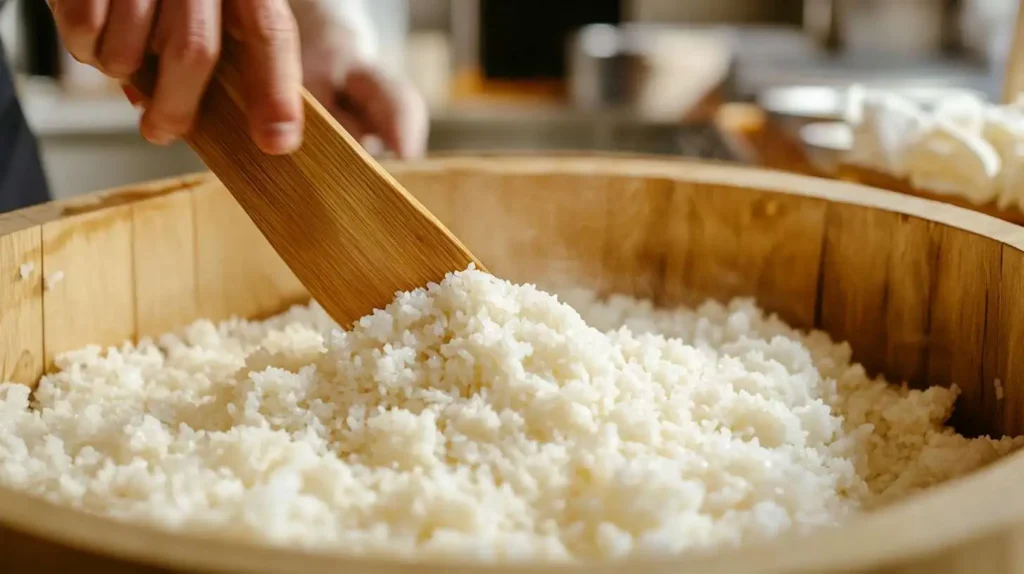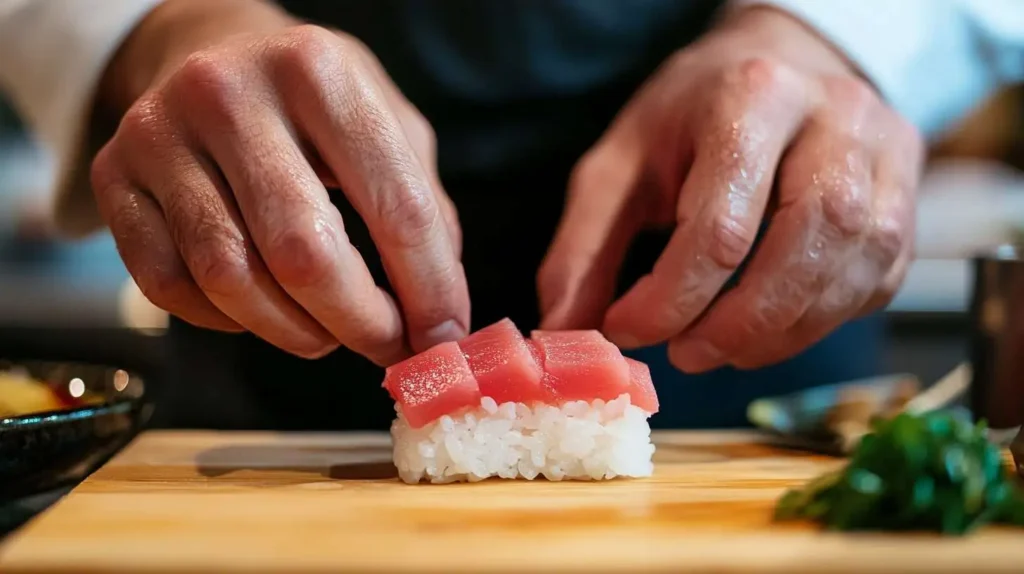Imagine sitting at a quiet sushi bar in Tokyo, the scent of fresh seafood lingering in the air. The chef, a master of his craft, moves with precision, shaping a small mound of seasoned rice in his hand. With a delicate touch, he places a slice of glistening fish on top, pressing gently to create the perfect balance. He hands it to you, and as you take a bite, the flavors melt together—sweet, salty, umami—all in one harmonious moment. This is nigiri sushi, a true masterpiece of Japanese cuisine.
Unlike rolls packed with layers of ingredients, nigiri sushi showcases simplicity and refinement. The chef carefully places a thin slice of fish on seasoned rice, adding just a touch of wasabi. Its beauty comes from this minimalism. Skilled hands craft each piece with precision, experience, and deep respect for tradition. But how did this elegant dish originate? What makes it stand out from other types of sushi? And most importantly—how can you truly appreciate it?
In this guide, we’ll take you through the history, ingredients, preparation, and etiquette of nigiri sushi. Whether you’re a sushi lover or a curious beginner, this journey will deepen your understanding and appreciation of one of Japan’s most treasured culinary arts.
Table of contents
Ingredients Used in Nigiri Sushi
At first glance, nigiri sushi seems simple—just a piece of fish on top of rice. But behind this simplicity lies a delicate balance of flavors and textures, made possible by a few essential ingredients. If you’re interested in trying other sushi varieties, you might enjoy learning how to make a Boston roll sushi, which incorporates fresh seafood and creamy avocado.

Each component plays a crucial role in creating the perfect bite. Let’s explore the key ingredients that bring nigiri sushi to life.
1. Sushi Rice (Shari) – The Foundation of Nigiri
Nigiri sushi starts with sushi rice, known as shari or sumeshi in Japanese. This isn’t just ordinary rice—it’s short-grain rice, carefully cooked and seasoned with a blend of rice vinegar, sugar, and salt. The rice must be slightly sticky to hold its shape but still light and fluffy to complement the topping.
- Short-grain Japanese rice: The base ingredient, known for its slightly sticky texture.
- Rice vinegar: Adds a subtle tang and enhances flavor.
- Sugar & salt: Balances the acidity of the vinegar, giving the rice a mild sweetness.
Getting the rice right is one of the most important steps in making authentic nigiri sushi. If it’s too wet, the nigiri will fall apart; if too dry, it won’t hold together properly.
2. Fish or Other Toppings (Neta) – The Star of the Show
The topping, or neta, is what makes each nigiri unique. The most traditional and popular choices include:
- Tuna (Maguro) – A sushi staple, offering a rich, meaty texture.
- Salmon (Sake) – Buttery and smooth, often served raw or lightly seared.
- Yellowtail (Hamachi) – A delicate fish with a hint of sweetness.
- Shrimp (Ebi) – Often boiled or butterflied for a slightly firmer texture.
- Eel (Unagi/Anago) – Cooked and glazed with a sweet soy-based sauce.
- Octopus (Tako) – Slightly chewy, often blanched before serving.
- Scallop (Hotate) – Soft and slightly sweet, a delicacy in sushi bars.
Freshness is key when selecting fish for nigiri sushi. The best sushi chefs source their seafood daily, ensuring a clean, ocean-like taste. If you’re a fan of seafood, you might also love preparing snow crab legs, a delicious and versatile ingredient that can be enjoyed in various dishes.
3. Wasabi – The Hidden Kick
Tucked between the rice and the fish, wasabi adds a burst of heat and enhances the overall flavor. Real wasabi comes from the wasabi plant and has a mild, fragrant heat. However, many restaurants use a substitute made from horseradish and mustard.
Wasabi isn’t just for spice—it also has antibacterial properties, helping to neutralize any bacteria in raw fish.
4. Soy Sauce – The Final Touch
Diners often dip nigiri sushi lightly in soy sauce (shoyu) before eating. But there’s a trick—only the fish, not the rice, should touch the soy sauce. Using too much can overpower the delicate flavors of the fish. Some types of nigiri, like unagi (eel), already have a special eel sauce (tare), so they don’t require extra soy sauce.
5. Optional Garnishes and Enhancements
Depending on the style and the chef’s preference, nigiri sushi may include additional elements:
- Pickled ginger (Gari) – Served on the side as a palate cleanser.
- Nori (Seaweed strip) – Sometimes used to secure certain toppings like shrimp or egg (tamago).
- Yuzu or lemon zest – Adds a fresh citrus aroma.
- Chopped green onions or sesame seeds – Used to enhance specific types of fish.
Simplicity at Its Finest
Nigiri sushi is all about balance—the perfect rice, the freshest fish, and just the right amount of wasabi and soy sauce. With so few ingredients, there’s no room for mistakes. Each element must be prepared with care, making even the simplest piece of nigiri a work of art.
How Nigiri Sushi is Made
The beauty of nigiri sushi lies in its simplicity, but making it requires skill, precision, and practice. Every step—from cooking the rice to shaping the sushi—requires careful attention. Here’s a step-by-step guide on how chefs traditionally prepare nigiri sushi.
Step 1: Preparing the Sushi Rice

- Rinse the rice – Rinse Japanese short-grain rice several times until the water runs clear. This process removes excess starch and prevents the rice from becoming too sticky.
- Cook the rice – Use the right amount of water to cook the rice, ensuring a texture that is slightly firm yet sticky enough to hold together.
- Season the rice – While still warm, mix the rice with a blend of rice vinegar, sugar, and salt to give it the signature sushi flavor.
- Cool the rice – Fan the seasoned rice gently to cool it down to body temperature, making it perfect for shaping.
Step 2: Slicing the Fish (Neta Preparation)
The topping, or neta, must be sliced properly to sit perfectly atop the rice. Chefs cut the fish against the grain to maintain a smooth, delicate texture.
- Thin slices (around 2-3 inches long) are preferred.
- The thickness of the cut varies depending on the type of fish—delicate fish like flounder may be thinner, while fattier fish like salmon can be slightly thicker.
Step 3: Shaping the Nigiri

Now comes the most delicate part—forming the nigiri by hand.
- Moisten hands – Sushi chefs dip their hands in a bowl of water mixed with rice vinegar to prevent sticking.
- Take a small amount of rice – Around 15-20 grams (a small golf ball size) of sushi rice is gently rolled into an oblong shape.
- Apply wasabi – A small dab of fresh wasabi is placed on the underside of the fish.
- Press the fish onto the rice – The sliced fish is carefully placed on top of the rice and gently pressed to form a firm but delicate bond.
A sushi chef will use three main touches to shape nigiri:
- The first press lightly secures the fish and rice together.
- The second press refines the shape, ensuring a smooth surface.
- The final press perfects the nigiri, making sure it holds its form without crushing the rice.
Step 4: Adding Final Touches
- Some nigiri pieces, like eel (unagi) or egg (tamago), may be wrapped with a thin strip of nori (seaweed) to hold everything together.
- Certain fish may be lightly torched (aburi-style) for a smoky flavor.
- Nigiri can be garnished with a touch of citrus zest, sesame seeds, or green onions for extra flavor.
Step 5: Serving Nigiri Sushi
Nigiri sushi is best served immediately after it’s made to ensure the freshest taste. It’s usually presented on a plate with:
- Pickled ginger (gari) – Cleanses the palate between bites.
- Soy sauce (shoyu) – For dipping, but only lightly!
- A small dollop of wasabi – If additional spice is desired.
Mastering the Art of Nigiri
While making nigiri sushi may look effortless when done by a professional, it takes years to perfect. From the careful selection of fish to the delicate handling of rice, every detail matters. But whether you’re dining at a top sushi bar or trying to make it at home, the key is to respect the ingredients and enjoy the simplicity of the dish.
Common Mistakes When Making Nigiri Sushi
Making nigiri sushi may seem simple, but even the smallest mistake can affect the taste, texture, and presentation. Whether you’re a beginner or an experienced home cook, avoiding these common errors will help you achieve restaurant-quality nigiri.
1. Using the Wrong Type of Rice
Mistake: Using long-grain rice instead of Japanese short-grain sushi rice. Long-grain rice, such as basmati or jasmine, lacks the necessary starch to hold its shape. For those exploring different types of rice in cooking, you might find this red rice recipe useful, as it offers a unique, nutritious alternative to traditional white rice
Solution: Always use short-grain Japanese rice (uruchimai), which is naturally sticky and has the right texture for sushi.
2. Overcooking or Undercooking the Rice
Mistake: Cooking rice incorrectly can lead to mushy or dry rice, making it difficult to shape properly.
Solution: Follow the correct water-to-rice ratio (usually 1:1.2) and let the rice steam properly after cooking to ensure the right consistency.
3. Skipping the Rice Seasoning
Mistake: Many people forget to season the rice with sushi vinegar (su-meshi), which gives nigiri its signature balance of sweet, tangy, and savory flavors.
Solution: Mix rice vinegar, sugar, and salt into the cooked rice while it’s still warm and fan it to cool evenly.
4. Not Handling the Rice Gently
Mistake: Squeezing or pressing the rice too hard, making the nigiri dense and heavy.
Solution: Shape the rice lightly with your fingers—just enough to hold together without crushing the grains. A good nigiri should feel soft but firm.
5. Using Low-Quality or Unfresh Fish
Mistake: Using low-quality or old fish can make your nigiri taste fishy or unsafe to eat.
Solution: Always choose sushi-grade fish from a reliable source. Fresh fish should be bright in color, smell clean (not fishy), and have a firm texture.
6. Cutting the Fish Incorrectly
Mistake: Cutting fish too thick, too thin, or in the wrong direction can affect its texture and mouthfeel.
Solution: Use a sharp knife and slice the fish against the grain to keep it tender. A good piece should be about 2-3 inches long, 1 inch wide, and thin enough to drape over the rice.
7. Overusing Wasabi
Mistake: Adding too much wasabi can overpower the delicate flavor of the fish.
Solution: Use just a small dab of wasabi between the fish and rice. Some fish, like eel (unagi), don’t need wasabi at all.
8. Dipping the Rice in Soy Sauce
Mistake: Submerging the rice side of the nigiri in soy sauce, causing it to fall apart and become too salty.
Solution: Dip only the fish side into the soy sauce lightly to avoid overpowering the natural flavors.
9. Ignoring Presentation and Balance
Mistake: Messy, uneven nigiri that lacks the elegance of professionally made sushi.
Solution: Practice shaping your nigiri evenly, making sure the fish sits neatly on top. Sushi is not just about taste—it’s about presentation, too!
FAQs About Nigiri Sushi
1. What is in nigiri sushi?
Nigiri sushi consists of two main components:
- Sushi rice (shari): Seasoned Japanese short-grain rice.
- Fish or seafood topping (neta): Common options include tuna, salmon, shrimp, and eel.
A small amount of wasabi is often placed between the rice and the fish, and it is served with soy sauce and pickled ginger (gari) on the side.
2. What is nigiri vs. sashimi?
- Nigiri is a hand-pressed sushi consisting of rice topped with a slice of fish or seafood.
- Sashimi is thinly sliced raw fish without rice.
Nigiri is eaten with soy sauce and wasabi, while sashimi is often served with shredded daikon radish and sometimes a dipping sauce like ponzu.
3. Is nigiri sushi unhealthy?
Nigiri sushi is generally healthy, as it consists of:
- Lean protein (fish) – Rich in omega-3 fatty acids, vitamins, and minerals.
- Rice (carbohydrates) – Provides energy but should be consumed in moderation.
However, excessive soy sauce, high-mercury fish (like tuna), or eating too much sushi rice can increase sodium and calorie intake. Enjoying nigiri in moderation as part of a balanced diet is the best approach.
4. Is nigiri eaten in one bite?
Yes! Nigiri sushi is traditionally eaten in one bite to experience the perfect balance of rice, fish, and wasabi. If the piece is too large, you can take two small bites, but avoid breaking it apart, as this can ruin the texture.
For the best experience:
- Pick up nigiri with chopsticks or clean hands.
- Dip the fish side (not the rice) lightly into soy sauce.
- Eat it in one smooth bite to enjoy the full combination of flavors.
Final Thoughts about Nigiri Sushi
Nigiri sushi is more than just a simple dish—it’s a work of art that requires precision, balance, and respect for ingredients. From the perfect sushi rice to the freshest fish, every element plays a crucial role in creating the ultimate bite.
Whether you’re enjoying it at a top sushi restaurant or making it at home, understanding the history, ingredients, and proper techniques behind nigiri sushi will deepen your appreciation for this classic Japanese delicacy.
So next time you take a bite of nigiri, savor the harmony of flavors, the craftsmanship behind each piece, and the rich tradition that makes sushi a global favorite.
Would you like me to add an image section and SEO metadata (meta description, SEO title, and tags)? Let me know!

